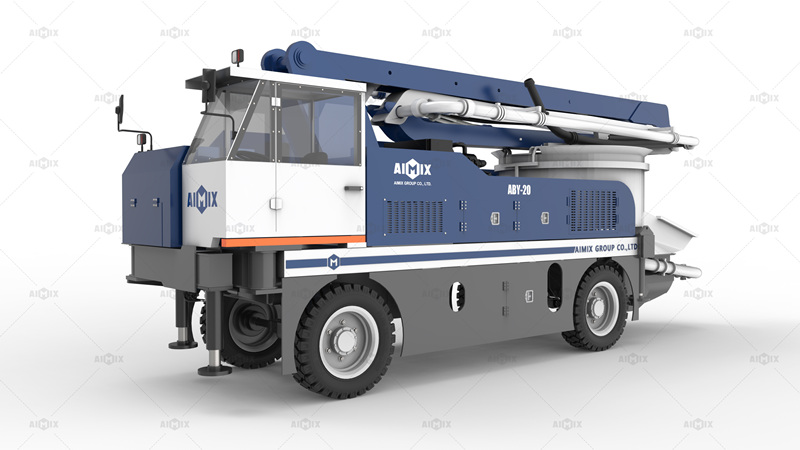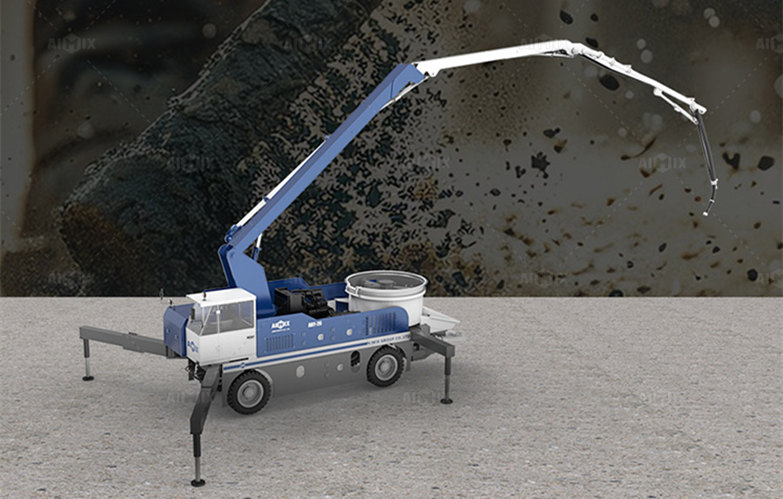How to Change the Tires for a Mobile Concrete Boom Pump
Mobile concrete boom pumps are essential equipment in construction projects, offering flexibility and efficiency in concrete placement. However, like any heavy-duty machinery, they require regular maintenance—especially tire care. Worn or damaged tires can lead to safety hazards, reduced mobility, and costly downtime.

This guide provides a step-by-step process for changing tires on a mobile concrete boom pump, including safety precautions, tools needed, and best practices to ensure smooth operation.
Safety Precautions Before Changing Tires
Before attempting to change the tires on a boom mobile concrete pump, follow these safety measures:
A. Park on a Stable, Level Surface
Avoid slopes or soft ground to prevent the pump from shifting.
Use wheel chocks to secure the vehicle.
B. Engage Parking Brake & Lower the Boom
Ensure the boom is fully retracted and locked to avoid accidental movement.
Disengage the hydraulic system to prevent pressure buildup.
C. Use Proper Lifting Equipment
A heavy-duty jack (50+ ton capacity) is required due to the pump's weight.
Never rely on hydraulic systems alone to support the machine during tire changes.
D. Wear Protective Gear
Steel-toe boots, gloves, and safety glasses are mandatory.
High-visibility vests should be worn if working near traffic.
Tools & Equipment Needed
Before starting, gather the following:
- Tool | Purpose |
- ----------|------------|
- 50-ton hydraulic jack | Lifting the pump safely |
- Jack stands | Additional support |
- Lug wrench (heavy-duty) | Removing lug nuts |
- Torque wrench | Properly tightening lug nuts |
- Tire pry bars | Removing stubborn tires |
- Bead breaker (if needed) | Separating tire from rim |
- Air compressor | Inflating new tires |
- Wheel chocks | Preventing vehicle movement |
Step-by-Step Guide to Changing Tires
Step 1: Loosen Lug Nuts Before Lifting
Use a heavy-duty lug wrench to slightly loosen (but not remove) the lug nuts while the tire is still on the ground.
This prevents the wheel from spinning when lifted.
Step 2: Lift the Pump with a Hydraulic Jack
Position the jack under the approved lifting points (refer to the pump's manual).
Lift just enough to remove the tire (typically 6-12 inches).
Place jack stands for extra stability.
Step 3: Remove the Old Tire
Fully unscrew and remove the lug nuts.
Carefully pull the wheel straight off the hub.
If the tire is stuck, use tire pry bars to gently release it.
Step 4: Install the New Tire
Align the new wheel with the hub bolts.
Hand-tighten the lug nuts in a star pattern (to ensure even pressure).
Step 5: Lower the Pump & Torque Lug Nuts Properly
Lower the jack until the tire touches the ground.
Use a torque wrench to tighten lug nuts to the manufacturer's specifications (typically 450-600 ft-lbs for heavy-duty pumps).
Step 6: Check Tire Pressure & Inspect
Inflate the new tire to the recommended PSI (usually 80-120 PSI for concrete pumps).
Perform a visual inspection for leaks or misalignment.
Common Challenges & Solutions
A. Stuck or Rusted Lug Nuts
Solution: Apply penetrating oil (e.g., WD-40) and let it sit before attempting removal.
B. Damaged Wheel Studs
Solution: Replace broken studs immediately—never operate with missing or damaged studs.
C. Bead Sealing Issues (Tire Won't Inflate)
Solution: Use a bead sealer lubricant or a cheetah bead blaster to reseat the tire.
D. Uneven Tire Wear
Solution: Rotate tires regularly and check wheel alignment.
When to Call a Professional
While changing tires on a mobile concrete boom pump can be done in-house, consider hiring a professional if:
✔ The pump has dual or super-single tires (complex removal).
✔ The wheel hub is damaged and needs replacement.
✔ You lack proper lifting equipment (risk of injury or machine damage).
Preventative Maintenance Tips
To extend tire life and reduce replacements:
✅ Check tire pressure weekly (underinflation causes overheating).
✅ Rotate tires every 500-1,000 hours of operation.
✅ Inspect for cuts, bulges, or uneven wear before each job.
✅ Avoid overloading beyond the pump's rated capacity.
Changing tires on a mobile concrete boom pump is a critical maintenance task that ensures safety, mobility, and operational efficiency. By following this guide, operators can minimize downtime and prevent costly repairs.
For heavy-duty or complex tire changes, always consult the manufacturer's manual or hire a certified technician. Proper tire maintenance not only extends equipment life but also reduces job site risks.
